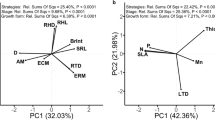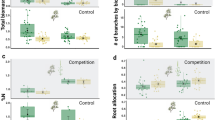Abstract
Key message
The endangered status and narrow distribution in Syringa pinnatifolia , a sub-alpine shrub species, were primarily caused by its poor drought adaptation related to its lower degree of physiological adjustment despite its greater degree of morphological plasticity.
Abstract
Although deep rooting is usually considered a drought-tolerant trait, we found that Syringa pinnatifolia, a deep rooting and hydrotropic shrub, has a limited distribution in arid areas. To elucidate the mechanisms for its narrow distribution, we conducted two experiments to examine the physiological and morphological responses to water availability and heterogeneity in S. pinnatifolia and a widespread congeneric species, S. oblata. We measured gas exchange, water use efficiency, and plasticity index in plants of these two species grown at different levels of soil water regimes and in containers with patched water distribution. Our results showed that high photosynthetic capacity in the narrowly distributed S. pinnatifolia was an important factor enabling its survival in the harsh sub-alpine environment. High photosynthetic capacity in S. pinnatifolia, however, was obtained at the expense of high transpiratory water loss, resulting in lower integrative water use efficiency. Biomass allocation to roots in S. pinnatifolia increased by 73 % when soil water increased from 75 to 95 % field capacity, suggesting that S. pinnatifolia could be less competitive for above-ground resources under favorable water regimes. The horizontal root hydrotropism and vertical root hydrotropism of S. pinnatifolia in soil with patched water patterns were likely related to compensation for leaf water loss at low soil water level, indicating a limited capacity for homeostasis within the plant for water conservation and lower level of inherent drought-tolerance. In summary, greater degree of morphological plasticity but lower degree of physiological adjustment may be the main causes for the hydrotropism and narrow distribution of S. pinnatifolia in the sub-alpine habitats.







Similar content being viewed by others
References
Aasamaa K, Sober A, Rahi M (2001) Leaf anatomical characteristics associated with shoot hydraulic conductance, stomatal conductance and stomatal sensitivity to changes of leaf water status in temperate deciduous trees. Aust J Plant Physiol 28:765–774
Alvarez-Yepiz JC, Dovciak M, Burquez A (2011) Persistence of a rare ancient cycad: effects of environment and demography. Biol Conserv 144:122–130
Cassab GI, Eapen D, Campos ME (2013) Root hydrotropism: an update. Am J Bot 100:14–24
Chang MC, Qiu LQ (1992) Flora Reipublicae Popularis Sinicae Tomus. Science Press, Beijing
Davis SD (1989) Patterns in mixed Chaparral stands: differential water status and seedling survival during summer drought. In: S.C. K (ed) The California Chaparral: paradigms reexamined, vol 34. Natural History Museum of Los Angeles County, Los Angeles, CA, pp 97–105
Davis SD, Mooney HA (1986) Tissue water relations of four co-occurring chaparral shrubs. Oecologia 70:527–535
de Witt TJ, Sih A, Wilson DS (1998) Costs and limits of phenotypic plasticity. Trends Ecol Evol 13:77–81
Drouet JL, Pages L (2003) GRAAL: a model of GRowth, Architecture and carbon Allocation during the vegetative phase of the whole maize plant: model description and parameterisation. Ecol Model 165:147–173
Fisher RA, Turner NC (1978) Plant productivity in the arid and semiarid zones. Ann Rev Plant Physiol 29:277–317
Fu KJ, Zhang ZY (1992) Plant Red Book of China. Science Press, Beijing
Fu PL, Jiang YJ, Wang AY, Brodribb TJ, Zhang JL, Zhu SD, Cao KF (2012) Stem hydraulic traits and leaf water-stress tolerance are co-ordinated with the leaf phenology of angiosperm trees in an Asian tropical dry karst forest. Ann Bot 110:189–199
Gao Y, Cui HX, Shi L, Qu YY (2008) Characteristics of leaf epidermis of Syringa and the association with their environmental adaptation and systematics. Acta Bot Boreal Occident Sin 28:475–484
Givnish TJ (2002) Ecological constraints on the evolution of plasticity in plants. Evol Ecol 16:213–242
Godoy O, Valladares F, Castro-Diez P (2012) The relative importance for plant invasiveness of trait means, and their plasticity and integration in a multivariate framework. New Phytol 195:912–922
Grams TEE, Anderson CP (2007) Competition for resources in trees: physiological versus morphological plasticity. In: Esser KLU, Beyschlag W, Murata J (eds) Progress in botany, vol 68. Springer, Berlin, p 372
Gregory PJ (2006) Roots and the architecture of root systems. Plant roots: growth, activity and interaction with soils. Wiley, New Jersey, p 328
Gutschick VP, BassiriRad H (2003) Extreme events as shaping physiology, ecology, and evolution of plants: toward a unified definition and evaluation of their consequences. New Phytol 160:21–42
Hetherington AM, Woodward FI (2003) The role of stomata in sensing and driving environmental change. Nature 424:901–908
Huner NPA, Oquist G, Sarhan F (1998) Energy balance and acclimation to light and cold. Trends Plant Sci 3:224–230
Huxman KA, Smith SD, Neuman DS (1999) Root hydraulic conductivity of Larrea tridentata and Helianthus annuus under elevated CO2. Plant Cell Environ 22:325–330
Jones MB (1985) Plant Microclimate. In: Coombs J, Hall DO, Long SP, Scurlock JMO (eds) Techniques in bioproductivity and photosynthesis. Pergamon Press, Oxford, pp 26–40
Jones HG (1992) Plants and microclimate: a quantitative approach to environmental plant physiology. Cambridge University Press, Cambridge
Kephart SR, Paladin C (1997) Demographic change and microhabitat variability in a grassland endemic, Silene douglasii var. oraria (Caryophyllaceae). Am J Bot 84:179–189
Loik ME, Breshears DD, Lauenroth WK, Belnap J (2004) A multi-scale perspective of water pulses in dryland ecosystems: climatology and ecohydrology of the western USA. Oecologia 141:269–281
Maroco JP, Pereira JS, Chaves MM (2000) Growth, photosynthesis and water-use efficiency of two C4 Sahelian grasses subjected to water deficits. J Arid Environ 45:119–137
Matthies D, Brauer I, Maibom W, Tscharntke T (2004) Population size and the risk of local extinction: empirical evidence from rare plants. Oikos 105:481–488
Mooney HA, Chairiello NR (1984) The study of plant function—the plant as a balanced system. Sinauer Press, Sunderland
Nepstad DC, de Carvaiho CR, Davidson EA, Jipp PH, Lefebvre PA, Negreiros GH, da Silva ED, Stone TA, Trumbore SE, Vieira S (1994) The role of deep roots in the hydrological and carbon cycles of Amazonian forests and pastures. Nature 372:666–699
Nicotra AB, Babicka N, Westoby M (2002) Seedling root anatomy and morphology: an examination of ecological differentiation with rainfall using phylogenetically independent contrasts. Oecologia 130:136–145
North GB, Nobel PS (2000) Heterogeneity in water availability alters cellular development and hydraulic conductivity along roots of a desert succulent. Ann Bot 85:247–255
Ohlemuller R, Anderson BJ, Araujo MB, Butchart SHM, Kudrna O, Ridgely RS, Thomas CD (2008) The coincidence of climatic and species rarity: high risk to small-ranges species from climatic change. Biol Lett 4:568–572
Partel M, Helm A, Ingerpuu N, Reier U, Tuve EL (2004) Conservation of Northern European plant diversity: the correspondence of soil pH. Biol Conserv 120:525–531
Peleg Z, Fahima T, Abbo S, Krugman T, Nevo E, Yakir D, Saranga Y (2005) Genetic diversity for drought resistance in wild emmer wheat and its ecogeographical associations. Plant Cell Environ 28:176–191
Rambal S (1993) The differential role of mechanisms for drought resistance in a Mediterranean evergreen shrub: a simulation approach. Plant Cell Environ 16:525–531
Schuster WSF, Phillips SL, Sandquist DR, Ehleringer JR (1992) Heritability of carbon isotope discrimination in Gutierrezia microcephala (Asteraceae). Am J Bot 79:216–221
Steinger T, Roy BA, Stanton ML (2003) Evolution in stressful environments II: adaptive value and costs of plasticity in response to low light in Sinapis arvensis. J Evol Biol 16:313–323
Valladares F, Wright SJ, Lasso E, Kitajima K, Pearcy RW (2000) Plastic phenotypic response to light of 16 congeneric shrubs from a Panamanian Rainforest. Ecol Model 81:1925–1936
Valladares F, Gianoli E, Gomez JM (2007) Ecological limits to plant phenotypic plasticity. New Phytol 176:749–763
Vilagrosa A, Bellot J, Vallejo VR, Gil-Pelegrin E (2003) Cavitation, stomatal conductance, and leaf dieback in seedlings of two co-occurring Mediterranean shrubs during an intense drought. J Exp Bot 54:2015–2024
Acknowledgments
This work was financially supported in part by the National Science Foundation of China [30570175], [31370361], and the Knowledge Innovation Project of Chinese Academy of Sciences [KSCX2-YW-Z-059, KSCX2-EW-B-5], and 863-2013AA102903.
Author information
Authors and Affiliations
Corresponding authors
Ethics declarations
Conflict of interest
The authors declare that they have no conflict of interest.
Additional information
Communicated by K. Masaka.
Rights and permissions
About this article
Cite this article
Cui, H., Cong, S., Wang, X. et al. Mechanistic examination of causes for narrow distribution in an endangered shrub: a comparison of its responses to drought stress with a widespread congeneric species. Trees 30, 2227–2236 (2016). https://doi.org/10.1007/s00468-016-1448-8
Received:
Accepted:
Published:
Issue Date:
DOI: https://doi.org/10.1007/s00468-016-1448-8




